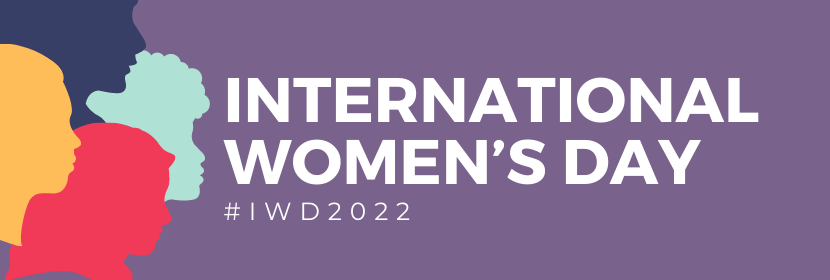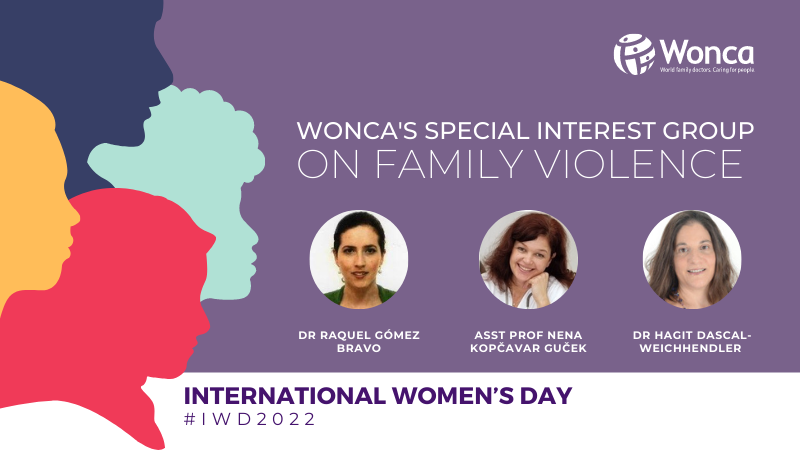IWD2022: WONCA SIG on Family Violence

Nearly 1 in 3 women globally have experienced intimate partner violence or any sexual violence in their life time. Sexual abuse, child abuse, elder abuse and other forms of gender based violence are also major public health problems, more frequent than most chronic diseases we treat as physicians daily. Examples of Gender Based Violence (GBV) include domestic violence, sex based violence or harassment, female genital mutilation (FGM), forced marriage. COVID-19 has shaken society in all possible ways, leading to dreadful consequences not only caused, but definitely exacerbated, by the virus. Governments’ responses to stop the spread of the infection have forced many families to stay at home, triggering or aggravating cases of violence within families, against all vulnerable members, including women and girls, and transforming this into what has been called the shadow pandemic.
Violence not only affects mortality, it has significant and long term physical and mental health consequences, and it and tremendous monetary and social costs to society. Fighting against Family and Gender Based Violence is society's responsibility. In the 2030 UN agenda for Sustainable Development proposed in 2015, many countries have committed to meet 17 goals by 2030. Two of them address violence directly, SDG 16 and SDG5. Global Goal 5 (SDG5) aims to achieve gender equality and one of its specific targets is to “eliminate all forms of violence against women and girls in the public and private spheres, including trafficking and sexual and other types of exploitation”.
We – as primary health care providers - have a crucial role! We may see patients in acute conditions, but also mostly have long term relationships with several family members, providing many opportunities to recognize violence is occurring and to offer help and referral to other agencies and specific resources. If these are not available we can provide a first line response, as guided by the WHO'S LIVES Model. Most of us were not trained sufficiently on this topic. Theoretical understanding of the complexity and dynamics of violence, as well as practical skills are necessary. We need to acquire the necessary competencies so we can do more good than harm. Let’s strengthen healthcare providers and systems, and primary care specifically, to play a more significant role in order to take proper care of our patients, especially the most vulnerable ones, without leaving anyone behind. Let’s act and move forward towards a zero-tolerance society.
WONCA SIG on Family Violence's recommendations, endorsed by WONCA Executive (February 2018):
1. Encourage each national college and academy to develop policy and implementation strategies on family violence identification and response for intimate partner violence, child abuse and elder abuse.
2. National colleges and academies promote basic training at undergraduate, graduate and continuing professional development on identification and support for family violence survivors and their children, recognising the critical need for a systems approach and adequate support for family doctors to undertake this sensitive work.
3. Contribute to the development of primary care based research, performance and outcome measures for general practitioners/family doctors and primary care teams in each of our member nations to enable evaluation of family violence care.
4. Assist in making information on family violence accessible on national and international web sites, sharing information and quality resources for interdisciplinary collaboration for health care, advocacy and legal support of families. Policy and practice guidelines should recognise the need for culturally safe strategies for vulnerable groups and adaptation of care to health care settings in high, middle and low income countries
We should not be confused: addressing and treating violence requires a systemic multidisciplinary approach, including many governmental and nongovernmental agencies and services. Nevertheless we cannot forget our own role and responsibility / response-ability as a group and as individuals!

We will be glad to meet you in our workshops/presentations in upcoming conferences.
You can find more resources, including our May 2020 Webinar in the attached links:
WONCA FAMILY VIOLENCE WEBINAR - Bing video
Global Family Doctor - WONCA Online
DV RESOURCES FV SIG 5.5.20.pdf (globalfamilydoctor.com)
SIG FV call to action 18.pdf (globalfamilydoctor.com)
Violence against women prevalence estimates, 2018 – Global fact sheet (who.int)
WHO Global Database on the Prevalence of Violence Against Women –
interactive map
Map (srhr.org)
World Health Organization. Health care for women subjected to intimate partner violence or sexual violence: A clinical handbook [Internet]. 2014 [cited 2021 Sep 21].
Available from:
https://www.who.int/reproductivehealth/publications/violence/vaw-clinical-handbook/en/
REFERENCES
Bonomi AE, Anderson ML, Reid RJ, Rivara FP, Carrell D, Thompson RS. Medical and Psychosocial Diagnoses in Women With a History of Intimate Partner Violence. Arch Intern Med [Internet]. 2009 Oct 12 [cited 2021 Sep 28];169(18):1692–7. Available from: https://jamanetwork.com/journals/jamainternalmedicine/fullarticle/773615
CDC: Timeline of Violence as a Public Health Problem |Violence Prevention|Injury Center|CDC [Internet]. [cited 2021 Sep 28]. Available from: https://www.cdc.gov/violenceprevention/about/timeline.html
Gómez Bravo R, Mariani Borrero Y, Dascal-Weichhendler H, Kopcavar Gucek N, Fischer VJ, Lygidakis C, Vögele C. Family violence and COVID-19. The Ends of Humanities - Volume 2: Self and Society in the Corona Crisis. ISBN: 978-2-9199648-7-1. Melusina Press 2020. Editors: Georg Mein, Johannes Pause. DOI: https://doi.org/10.26298/bxaj-cq22
Rivara FP, Anderson ML, Fishman P, Bonomi AE, Reid RJ, Carrell D, et al. Healthcare Utilization and Costs for Women with a History of Intimate Partner Violence. Am J Prev Med. 2007 Feb 1;32(2):89–96.
WHO: Violence against women prevalence estimates, 2018 – Global fact sheet (who.int)